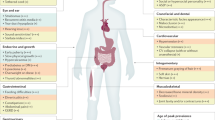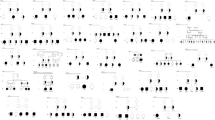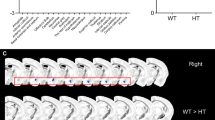Abstract
Williams–Beuren syndrome (WBS) is a developmental disorder with characteristic physical, cognitive and behavioural traits caused by a microdeletion of ∼1.5 Mb on chromosome 7q11.23. In total, 24 genes have been described within the deleted region to date. We have isolated and characterised a novel human gene, GTF2IRD2, mapping to the WBS critical region thought to harbour genes important for the cognitive aspects of the disorder. GTF2IRD2 is the third member of the novel TFII-I family of genes clustered on 7q11.23. The GTF2IRD2 protein contains two putative helix-loop-helix regions (I-repeats) and an unusual C-terminal CHARLIE8 transposon-like domain, thought to have arisen as a consequence of the random insertion of a transposable element generating a functional fusion gene. The retention of a number of conserved transposase-associated motifs within the protein suggests that the CHARLIE8-like region may still have some degree of transposase functionality that could influence the stability of the region in a mechanism similar to that proposed for Charcot–Marie–Tooth neuropathy type 1A. GTF2IRD2 is highly conserved in mammals and the mouse ortholgue (Gtf2ird2) has also been isolated and maps to the syntenic WBS region on mouse chromosome 5G. Deletion mapping studies using somatic cell hybrids show that some WBS patients are hemizygous for this gene, suggesting that it could play a role in the pathogenesis of the disorder.
Similar content being viewed by others
Log in or create a free account to read this content
Gain free access to this article, as well as selected content from this journal and more on nature.com
or
References
Morris C : The natural history of Williams syndrome: physical characteristics. J Paediatr 1988; 113: 318–326.
Pober B, Dykens E : Williams syndrome: an overview of medical, cognitive, and behavioural features. Child Adolesc Psychiatr Clin N Am 1996; 5: 929–943.
Valero M, de Luis O, Cruces J, Pérez Jurado L : Fine-scale comparative mapping of the human 7q11.23 region and the orthologous region on mouse chromosome 5G: the low-copy repeats that flank the Williams–Beuren syndrome deletion arose at breakpoint sites of an evolutionary inversion(s). Genomics 2000; 69: 1–13.
Tassabehji M, Metcalfe K, Karmiloff-Smith A et al: Williams syndrome: use of chromosomal microdeletions as a tool to dissect cognitive and physical phenotypes. Am J Hum Genet 1999; 64: 118–125.
Ewart A, Morris C, Atkinson D et al: Hemizygosity at the elastin locus in a development disorder, Williams syndrome. Nat Genet 1993; 5: 11–16.
Roy A : Biochemistry and biology of the inducible multifunctional transcription factor TFII-I. Gene 2001; 274: 1–13.
Vullhorst D, Buonanno A : Characterisation of general transcription factor 3, a transcription factor involved in slow muscle-specific gene expression. J Biologic Chem 2003; 278: 8370–8379.
Rice P, Longden I, Bleasby A : EMBOSS: the European molecular biology open software suite. Trends Genet 2000; 16: 276–277.
Thompson J, Higgins D, Gibson T : CLUSTAL W: Improving the sensitivity of progressive multiple sequence alignment through sequence weighting, position-specific gap penalties and weight matrix choice. Nucleic Acids Res 1994; 22: 4673–4680.
Wilkins M, Gasteiger E, Bairoch A et al: Protein identification and analysis tools in the ExPASy server; In: Link A (ed): 2-D proteome analysis protocols. New Jersey, Humana Press; 1998.
Bateman A, Birney E, Cerrut L et al: The Pfam protein families database. Nucleic Acids Res 2002; 30: 276–280.
Gattiker A, Gasteiger E, Bairoch A : ScanProsite: a reference implementation of a PROSITE scanning tool. Appl Bioinform 2002; 1: 107–208.
Altschul S, Madden T, Schäffer A et al: Gapped BLAST and PSI-BLAST: a new generation of protein database search programs. Nucleic Acids Res 1997; 25: 3389–3402.
Nakai K, Kanehisa M : A knowledge base for predicting protein localization sites in eukaryotic cells. Genomics 1992; 14: 897–911.
Smit A, Green P RepeatMasker program, unpublished data.
Nielsen H, Engelbrecht J, Brunak S, von Heijne G : Identification of prokaryotic and eukaryotic signal peptides and prediction of their cleavage sites. Protein Eng 1997; 10: 1–6.
Emanuelsson O, Nielsen H, Brunak S, von Heijne G : Predicting subcellular localization of proteins based on their N-terminal amino acid sequence. J Mol Biol 2000; 300: 1005–1016.
Wilmot C, Thornton J : Beta-turns and their distortions: a proposed new nomenclature. Protein Eng 1990; 3: 479–493.
Ferré-D'Amar A, Prendergast G, Ziff E, Burley S : Recognition by Max of its cognate DNA through a dimeric b/HLH/Z domain. Nature 1993; 363: 38–45.
Aravind L : The BED finger, a novel DNA-binding domain in chromatin-boundary-element-binding proteins and transposases. Trends Biologic Sci 2000; 25: 421–423.
Jurka J, Naik A, Kapitonov V : CHARLIE8 RepBase entry RepBase release 7.2. (Accessed 7th November 2002) 1998.
Smit A : Interspersed repeats and other mementos of transposable elements in mammalian genomes. Curr Opin Genet Dev 1999; 9: 657–663.
Smit A, Riggs A : Tiggers and other DNA transposon fossils in the human genome. Proc Natl Acad Sci USA 1996; 93: 1443–1448.
Calvi B, Hong T, Findley S, Gelbert W : Evidence for a common evolutionary origin of inverted repeat transposons in drosophila and plants; hobo, Activator, and Tam3. Cell 1991; 66: 465–471.
Kulkosky J, Jones K, Katz R, Mack J, Skalka A : Residues critical for retroviral integrative recombination in a region that is highly conserved among retroviral/retrotransposon integrases and bacterial insertion sequence transposases. Mol Cell Biol 1992; 12: 2331–2338.
Esposito T, Gianfrancesco F, Ciccodicola A et al: A novel pseudoautosomal human gene encodes a putative protein similar to Ac-like transposases. Hum Mol Genet 1999; 8: 61–67.
Kipling D, Warburton P : Centromeres, CENP-B and Tigger too. Trends Genet 1997; 13: 141–145.
McCarron M, Duttaroy A, Doughty G, Chovnick A : Drosophila P element transposase induces male recombination additively and without requirement for a P element excision or insertion. Genetics 1994; 136: 1013–1023.
Kiyosawa H, Chance P : Primate origin of the CMT1A-REP repeat and analysis of a putative transposon-associated recombinational hotspot. Hum Mol Genet 1996; 5: 745–753.
Reiter L, Murakami T, Koeuth T et al: A recombination hotspot responsible for two inherited peripheral neuropathies is located near a mariner transposon-like element. Nat Genet 1996; 12: 288–297.
Acknowledgements
This research was supported by the Wellcome Trust (Grant No. 061183).
Author information
Authors and Affiliations
Corresponding author
Rights and permissions
About this article
Cite this article
Tipney, H., Hinsley, T., Brass, A. et al. Isolation and characterisation of GTF2IRD2, a novel fusion gene and member of the TFII-I family of transcription factors, deleted in Williams–Beuren syndrome. Eur J Hum Genet 12, 551–560 (2004). https://doi.org/10.1038/sj.ejhg.5201174
Received:
Revised:
Accepted:
Published:
Issue date:
DOI: https://doi.org/10.1038/sj.ejhg.5201174
Keywords
This article is cited by
-
Fake IDs? Widespread misannotation of DNA transposons as a general transcription factor
Genome Biology (2023)
-
An Exploration of Social Cognition in Children with Different Degrees of Genetic Deletion in Williams Syndrome
Journal of Autism and Developmental Disorders (2021)
-
The nuclear localization pattern and interaction partners of GTF2IRD1 demonstrate a role in chromatin regulation
Human Genetics (2015)
-
Reliability of the nanopheres-DNA immunization technology to produce polyclonal antibodies directed against human neogenic proteins
Molecular Genetics and Genomics (2013)
-
Evolution of General Transcription Factors
Journal of Molecular Evolution (2013)



